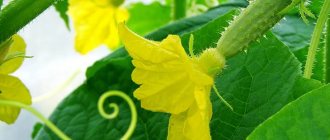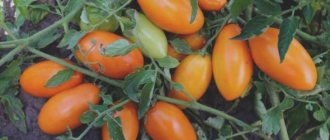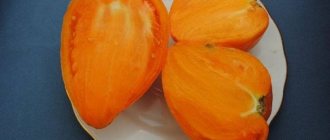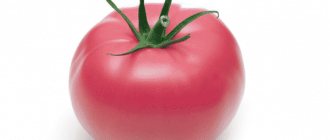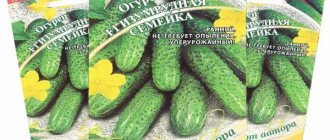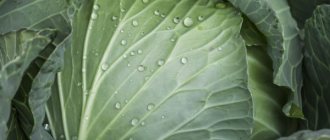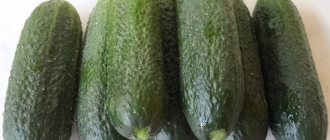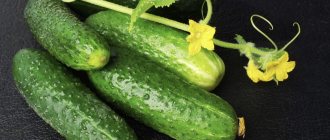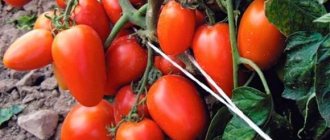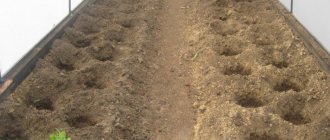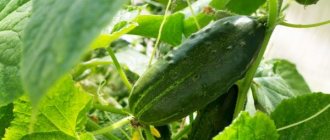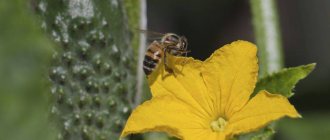Cucumber Break F1 is a proven adapted hybrid, characterized by excellent taste, productivity, and marketability. It is recommended for growing in greenhouse conditions and rarely gets sick. To increase productivity, it is enough to adhere to the frequency of watering and fertilizing.
| Landing location | Ripening time | Mode of application | Fruit length | Group | Fruit smoothness | Pollination method |
| Greenhouse | Early ripening (35-45 days) | Universal | Short (gherkins) - less than 10 cm | Hybrid | Highly lumpy | Parthenocarpic |
Description of the variety
Break cucumber was developed by Russian specialists who are employees of the Gabrish company. Quite often, this hybrid variety is used in cultivation in various greenhouse and greenhouse conditions.
This variety of cucumbers belongs to the female type of flowering, which does not require insects such as bees for flower pollination processes. Each ovary is located using bundle methods. You can get high yields after 43 days after planting in the ground.
The variety is different:
- Due to its medium height with moderate branching, these plants do not have very many leaves, therefore, they are not dense. Also, the leaves are medium sized and smooth.
- It is worth noting the fact that huge amounts of ovary of the Break cucumber varieties need special attention and increased amounts of non-root feeding.
- As for the fruits, they have a regular cylindrical shape with many medium-sized tubercles. The weight of one fruit can reach about 100 grams with a length of 11 cm. The peel of Break cucumbers is characterized by a dark green color with white blurred side stripes, the spines on cucumbers are white with frequent pubescence.
What grows on the bushes?
Early varieties of cucumbers have a salad purpose. When you try to preserve them, the fruits soften and acquire a sour taste.
Cucumber Break F1 has a universal purpose. Thrifty housewives roll up the surplus harvest for the winter. The taste of canned food pleases all family members.
Description of hybrid greens:
- fruit with sparse white spines;
- the flesh is crispy and juicy;
- the skin is dense, not rough;
- seeds are small;
- grows up to 11 cm in length;
- diameter up to 4 cm;
- bright green color with fuzzy light stripes;
- cucumbers grow up to 100 g.
Break's value is the genetic absence of bitterness. When harvesting is delayed, the fruits retain their skin color and the flesh remains tender.
See also
What to do with black leg on cucumbers, how to fight and saveRead
Characteristics of the variety
An interesting fact is that hybrids have universal applications, so they can be consumed:
- as fresh;
- in various salads;
- in canned;
- in pickled form;
- in various dishes.
It is also possible that picking gherkins will allow the cucumbers to acquire a crunchy taste from the inside. Many potential buyers who have already used this variety of cucumbers highlight the amazingly high taste in any form.
Do not forget that each plant has a high degree of protection from various diseases, for example, powdery mildew, downy mildew and root rot. The most basic advantages of this variety of Break cucumbers include:
- High yields.
- Not bad early maturity.
- Excellent resistance to many cucumber diseases.
- Excellent taste indicators.
- Friendly return of pods.
Preventive seed treatment
Seeds purchased at the store are placed in a disinfectant solution. At home, potassium permanganate is used. Add 2 teaspoons of potassium permanganate to ½ liter of warm water. The seed is placed in liquid for 2-3 hours. If there is no potassium permanganate, then hydrogen peroxide is poured into a saucer. The duration of water procedures is 1 hour. The second step is to place them in a growth stimulator for 2 days. On the positive side, the drugs “Epin” and “Kornevin” have proven themselves. The third step is to place the seeds in separate pots. Further procedure:
- trellises are placed on the beds to tie up the vines - it is advisable to use 2 or 3-level structures;
- watering is carried out immediately after transplanting into the ground;
- subsequently, watering is carried out once every 2 days;
- For 1 plant they consume 6 to 7 liters of warm water, which has previously been settled;
- in autumn, watering is carried out once every three days in a volume of 2 liters per plant;
- remove leaves located below the third node;
- carry out moderate pinching at the second and third levels of bushes;
- Pinching of the growth stem is carried out 1 month after planting.
Growing
Break cucumbers can be grown either using seedlings or seeds, but only in a greenhouse or greenhouse.
Seedling method
As for the seedling method, special importance should be given to picking and transplanting, so growing seedlings in a separate container will come in handy. But before this, the containers should be filled with nutritious soil mixtures that are used for the processes of growing cucumbers. Then, after planting in pots, the plants should be covered with film and the soil should be watered regularly. And after 25 days, you can observe the formed seedlings, which are quite ready for planting in the greenhouse.
Do you find it necessary to use peat pots?
Not really
Seed method
As for the method of growing using seeds, special attention should be paid to:
- Premature preparation of the soil for planting seeds, for example, the ground temperature should be within 20 degrees. After all, the seeds die while in cold soil, resulting in a long growing season.
- It is worth noting that the period for obtaining high yields is significantly reduced in greenhouse conditions.
- But at the same time, humidity and temperature should be controlled, lighting in greenhouse conditions should be uniform, which helps to increase the production of an excellent harvest.
How to provide your family with vegetables?
Break F1 is an early productive hybrid. To get a good harvest, you need to follow the recommendations of agronomists:
- growing through seedlings is more effective than sowing in a permanent place;
- When planting, place the seeds in a hole, 2 pieces at a time;
- deepen by 1.5 cm;
- After germination, leave a strong plant (carefully cut off weak ones with scissors);
- plant 25-day-old seedlings in a greenhouse;
- the Break cucumber hybrid requires a lighted place;
- planting should be done after returning cold weather;
- add rotted manure or mature (three-year-old) compost to the soil (a bucket of 2 sq. m);
- planting on heavy soils requires preliminary sanding;
- provide soil and air moisture;
- blind the first two lateral shoots in the area of the first leaf;
- tie up the main stem;
- monitor the lighting (pluck out excess leaves and shoots);
- removing the tendrils will force the plant to give up its strength to the ripening fruits;
- Before flowering, apply foliar fertilizing with nitrogen (every 10 days).
Cucumbers love loose, moist soil. Mulching with mown and dried grass will help preserve these qualities. In hot weather, containers of water placed in the greenhouse will reduce the temperature.
Break is sensitive to drafts. Ventilation is recommended through vents. To reduce the temperature, you should whitewash the greenhouse or cover the plantings with lutrasil.
Daily collection of greens stimulates the formation of ovaries. After fruiting has finished, the canes should be shortened and the soil loosened. Feed the plants with nitrogen: after 3–5 days, the re-formation of ovaries will begin.
Care
Since Break cucumbers are considered moisture-loving plants, they therefore require timely watering, which is considered an important contribution to obtaining excellent quality yields. Caring for the plant consists of the following mandatory measures:
- how to water (morning and evening);
- weeding;
- loosening the earth;
- temperature regime;
- fertilizing (2-3 times during the growing season).
Watering procedures should be repeated every three days, but at the same time watch the soil so as not to encounter an excess of moisture, as this will only lead to withering of the plants, reduced yield rates, and also the death of the cucumbers themselves. In addition, in order not to encounter various manifestations of diseases, you should use exclusively warm water masses.
As for fertilizing, many experts recommend introducing it together with water masses. In addition, do not forget about loosening the soil and weeding from various weeds and loads; such methods are preventive measures. They prevent the occurrence of various diseases, pests, and problems with plants.
Harvesting and storage
Break f1 begins to be collected, based on the description, in the first half of June. The cucumber ripens quickly and fruiting lasts until October. Zelentsy are collected in the morning, after 15-20 minutes. after watering. The variety is harvested every day.
The harvest is stored well - it can lie on the top shelf of the refrigerator for more than a week without losing its taste. The main thing is to store the cucumber immediately after harvesting it from the garden.
Diseases and pests
Although many experienced farmers and gardeners claim that this variety of cucumbers is characterized by high levels of resistance to many diseases, it never hurts to play it safe. Therefore, as preventive methods, many people use many different means that prevent the occurrence of diseases, that is, protect their crops.
The most common fungal diseases include, for example, rust, which leads to weakening of plants, drying out and death. As preventive measures against this disease, thinning of plantings should be used, as well as treating vegetables with Bordeaux mixtures about 5 times.
As for dangerous pests, the most important ones include:
- aphids;
- whitefly;
- spider mite
At the same time, to combat aphids, manual collection of insects should be used, as well as treatment with special preparations. A similar method of control applies to other pests, only they use different drugs.
Seed planting method
In regions with warm climates, the seed planting method is used. Seed material is purchased and then necessarily disinfected. A preventative three-hour immersion in a weak solution of potassium permanganate will destroy possible pathogenic flora. The second step is immersion in a saturated saline solution. Seeds that sink to the bottom within 25-30 minutes can be used. Those remaining on the surface are disposed of. The third step is immersion of the selected seed material in a growth stimulator. Duration of bathing is 12 hours.
On a note!
The future harvest depends on the quality of soil preparation. In the fall, the remains of the previous harvest are removed and the soil is dug up. 1 month before the expected disembarkation, the procedure is repeated. Planting in open ground is carried out as soon as the temperature outside the window is consistently above + 20 C.
The seed cultivation method does not require significant experience and knowledge. The gardener’s task is to protect the seed from temperature shock, regularly feed and water moderately. The second detail is that in open ground, unlike greenhouses, it takes longer to obtain a harvest. The difference reaches 1-2 weeks. If a summer resident wants to play it safe, then first the prepared seeds are planted in temporary peat pots. The residence time of the seeds in them is 14-16 days. Further procedure:
- the depth of each hole is 5-8 cm;
- the distance between rows, depending on the area of the site, ranges from 15 to 30 cm;
- if there is not enough free space, then the seeds are planted in a checkerboard pattern;
- the landing site must be protected from drafts;
- The hybrid variety “Break F1” loves light, so without enough sun you won’t get a good harvest.
Immediately after planting, the seeds are buried in soil at the same level as the surrounding space. The completion of planting will be watering.
Photo
Thanks to the use of many photographs, potential buyers can easily find out what ripe fruits look like. This is what will help you make the right choice of variety, based not only on the qualities, but also on the properties of the specified plant. The photographs on the pages of our website are as detailed as possible and you have the opportunity not to lose sight of a single detail.
More about agricultural technology
Seeds can be planted immediately without prior preparation. Seedlings should be started in early April. When several (3-4) true leaves appear on the sprouts, the plant is ripe for planting in the place prepared for it. To make the soil nutritious and comfortable, you can use the following components: mix turf with humus, mix in peat and add sawdust and sand to the mixture to maintain an optimal level of substrate moisture.
Might be interesting
All basic procedures do not differ from caring for other early ripening varieties:
- How to water: cucumbers are 90% water, so watering is an important element of care. For it, settled water is usually used, as for indoor plants. Water in the evening so that the fruits can fully develop at night. Vegetables such as cucumbers require the right level of soil moisture, which should not be over-dried or over-watered. It is enough to moisten the soil once every 2-3 days (you need to pay attention to the climate and weather conditions, since in hot weather you should water more often, and vice versa in rainy weather).
- How to organize: form, taking into account the landing site. In the classic version, you can pinch and grow into 2 shoots.
- How to feed: when the young bushes are in a permanent place, they should be fertilized 2-3 times for better growth and development in a new habitat.
You can use substances such as potassium sulfate, superphosphate, saltpeter. Moisten with solutions of urea and mullein.
Advice!
Loosening should be deep enough, but you should be careful not to damage the root system.
Potassium sulfate, superphosphate, and saltpeter are added as fertilizer to the bushes. Water with solutions of urea and mullein.
Cucumber Break F1
"Break" is very tall, the main stem reaches a height of 2 meters. For normal cultivation, the construction of trellises with several levels is required. Ripe fruits are of medium length (up to 10 cm), weight about 100 grams. The variety is characterized by increased productivity (up to 20-25 kg per square meter), so it cannot be done without frequent heavy fertilizing. If they are neglected, then the plants will not have the strength to form and hold a large number of cucumbers. Taste and size deteriorate. When ripe, the skin acquires a rich dark green color. The taste of the pulp is unusual; it combines acidity and sweetness at the same time. The aroma of freshness is bright, and when cut, it spreads throughout the kitchen. When planting seeds in the ground, a depth of more than 1 cm is unacceptable, otherwise they will not germinate. Cucumbers thrive only in nutritious, fertile soil. For the beds you need to choose the right place. It should be well lit, preferably on the south side of the site. It is advisable to avoid drafts. Soil acidity should not be high. When preparing the soil, I make sure to use wood ash to avoid excessive acidification. Too close arrangement of bushes is unacceptable, otherwise there will not be a bountiful harvest.
I planted seedlings in a greenhouse. The agricultural technology is simple, I have been gardening for more than 10 years, without any special features. However, cucumbers of this variety grew earlier than all others; I planted 4 varieties! It was from the Break variety that I cut a cucumber, albeit small, but already ready to eat after 45 days. It is aromatic, with tender flesh and crispy skin. I myself am a little prickly, I collect it and wash it with gloves. I canned it starting in July and now we are eating it. In jars it is crispy, even hard, great for salads and vinaigrettes. The liana does not form the jungle, did not form it.
I planted this hybrid in a greenhouse; it does not require pollination, so it feels comfortable indoors. The yield is not the highest, 5-6 kg per bush when harvested regularly. Cucumbers are very neat and are best suited for sale. The fruits are light green, weigh up to 100 grams, the tubercles are noticeable, but they are not prickly to the touch. The pulp is juicy, crunchy when fresh, and does not wither for a long time. Only gherkins of this variety are suitable for pickling; the rest will turn out soft. The period from germination to the first harvest is 43 days, the foliage of the bushes is sparse, the bushes do not grow tall, but the stems must be pinched. There are usually few ovaries on the main branch, but on the side shoots there can be up to 8 of them. The variety is unpretentious in terms of care; I fertilized it from time to time with bio-feed, watered it every few days, loosened the soil, removed weeds and made mulch from hay. The bushes withstood temperature changes steadfastly, without disease, and then continued to bear fruit and bloom. You only need to control the temperature when germinating seeds - during this period you need to maintain increased heat from 25 to 30 degrees. As for me, the hybrid is not capricious, but in terms of taste and yield it is inferior to others.
Firm-
Cucumber seeds are supplied to the Russian vegetable seed market by several groups of producers. Imports are represented mainly by the global corporations Monsanto and Sakata. Russian cucumber selection successfully competes with foreign ones: agricultural firms Manul, Gavrish, Semko, Aelita, Sedek, Siberian Garden, Russian Garden, Seeds of Altai produce and independently package seeds for retail sales. Their own selection is underway in Siberia and other regions.
The breeders are the successors to the traditions of the Timiryazev Academy. They independently package their seeds for retail sales and sell them in bulk for packaging to other companies. You should beware of fakes: the range is very popular. It is better to take a package of cucumber seeds from Manul itself or other reliable companies.
Cucumber Emelya F1
This is an updated version of the Zozulya hybrid while maintaining its advantages. Parthenocarpic for any type of soil. In the Russian register since 2002. Adapts well to cool and cloudy weather. It stands out because it is not affected by root rot. Early ripening (39 days), with a friendly harvest and early mass yield.
Cucumber Grasshopper F1
This self-pollinating hybrid was included in the register in 2004. Early ripening (from 38 days). The bushes are long-climbing, not too branched. Shows excellent resistance to the main cucumber infections - downy mildew, powdery mildew, clodosporium, and viruses. Bunch ovary up to 6 pieces, with alternate filling. Pickled products of the highest quality.
Cucumber Lord F1
A hybrid for open ground, unique in its combination of characteristics. Perfect for the Middle and Northern regions. Included in the register in 2006 after serious tests. Medium in terms of the start of ripening, it produces a harvest almost before the onset of frost - thanks to cold resistance and immunity to all dangerous infections.
Requires replanting with several non-hybrid plants with male flowers, or the presence of bees for pollination. Excellent productivity is achieved due to the massive growth of ovaries (main stem) on numerous side shoots. It is more convenient to grow vegetables grown up, without a garter. A node produces up to two or three cucumbers.
Cucumber Cruise F1
The bee-pollinated hybrid was created by a team of breeders under the leadership of A.A. Mashtakov (Rostov-on-Don). On the register since 1997. Recommended for open ground in the Volga region and the Caucasus. Resistant to drought, peronospora and powdery mildew. Bush of medium length, with medium branching. Cucumbers 10 cm in size, 110 grams.
conducts active breeding work at the global level. It is better to purchase branded packaging. All modern Gavrishevsky cucumbers are not bitter. Thanks to targeted selection, each hybrid has its own characteristic features, “its own face.”
Cucumber Goosebumps F1
A rare feature for self-pollinating cucumbers is the black spines. This is a trademark of high quality conservation products. The fruits have a beautiful presentation - dark, dense, with evenly spaced medium-sized tubercles, elegant. Weight 95 grams, length 12 cm. The bushes are powerful, with dense leaves, an average degree of branching, and produce a yield of 7 kg.
Cucumber Courage F1
The high cost of Kurazh cucumber seeds pays off with an excellent harvest - a bucket from a bush. The self-pollinating plant is capable of simultaneously growing two dozen fruits. If you carry out pinching (remove side branches), then from each axil of the main stem, not the usual 3-5 ovaries grow, but 10-12 pieces. The central lash is long.
It quickly (from 40 days) enters long-term fruiting. The length of the harvested fruits - with dense pulp and a weight of about 110-115 grams - fluctuates about 12 cm. The tubercles are medium-sized, rather densely seated, white-pubescent. The hybrid is not susceptible to viruses, cladosporiosis, powdery mildew and downy mildew. The year of registration in the register is 2002.
The newest (2011) self-pollinating cucumber with a powerful branched bush and numerous bouquet ovaries - up to 10 per node with decent nutrition and good lighting. Harvesting is possible at the pickle and gherkin stage. Limit dimensions - 11 cm, 110 grams. The spines are light, rather densely located. The hybrid is resistant to all cucumber diseases. It begins to give greens on the 42nd day, amicably, for a long time.
Cucumber Mother-in-law F1
Contrary to popular belief, it differs significantly from the “paired” hybrid Zyatek. Included in the register in the same year, Mother-in-law has a more delicate taste (Zyatek is harsher), a strong aroma, and has brown thorns. The plant begins to bear fruit, unlike its “relative,” 4-7 days later, with 3-4 greens per node. The return of the greenies is extended. Resistance to infections is excellent.
Cucumber Berendey F1
The main feature is the ability of vegetables to bear fruit in the shade, which, combined with parthenocarpy and resistance to root rot, makes it possible to harvest even in an apartment. In greenhouses, cucumbers also perform well, producing buckets of fruit from the bush. As a rule, 3-4 ovaries are tied in knots. The size of the greens is 14 cm, 135 grams.
Cucumber Garland F1
A newer version (2010) of a shade-tolerant self-pollinating hybrid with the highest resistance to all cucumber diseases. Cultivated indoors, greenhouses; It can also be done outdoors. The main lash is long, the branching is very weak. Bouquet ovary - 4-5 pieces. The greens are dark, tuberculate, with light pubescence, dense, fragrant. Grows up to 13 cm, 125 grams. The purpose is universal.
Cucumber Zyatek F1
The most popular parthenocarpic for collecting pickles, gherkins, traditional greens (11 cm, 95 grams). The taste is excellent. The cucumber tubercles are quite dense, beautiful, and white-pubescent. Each node grows from 2 to 8 greens. Vegetable productivity is high. Fruits from 45 (plus or minus 3) days from the appearance of sprouts and for a long time.
Cucumber Break F1
This self-pollinating cucumber hybrid has been on the register since 2002. It is recommended for greenhouse crops, but also gave excellent results in open ground. Medium-sized, medium-branched. On the main stem it forms two or three ovaries in the axil of each leaf, and up to 8 on the branches. The bush gives a bucketful harvest. This is greatly facilitated by resistance to the most harmful infections - downy mildew, powdery mildew, and root rot. Zelentsy are 10 cm in size, 90 grams, excellent for preservation. They are often tuberculate, with light spines of medium size.
packages a variety of cucumbers from different manufacturers, but also offers its own interesting selection of these vegetables. All of the patented hybrids presented below are self-pollinating and do not taste bitter.
Cucumber Vanyusha F1
Mid-season new product (2010) for outdoor beds with particularly long fruiting. It has complex resistance to all infections. The bush is very branched, with a short main vine. It is more convenient to place the ridges. The ovaries grow in bunches of two or three pieces. The cucumbers are short, elongated-oval, 85 grams each.
Cucumber Espagnolette F1
Selection of recent years (2013) for open ground. The period of entry into fruiting is average (55 days). The bush branches weakly, the growth energy is concentrated in the main stem. Resistant to diseases. 2, sometimes 3 ovaries grow in a node. Finely pimpled greens are closer to average in weight, 85-95 grams each, with light pubescence, excellent taste. The purpose is universal.
Early hybrid - 40 (plus or minus 2) days from the appearance of sprouts. The fruits are thin-skinned, aromatic, small (9 cm), finely pimpled, beautiful. Plants are disease resistant. Branching is medium, the main stem is vigorous. There are up to 3 ovaries in the nodes. Collection per square meter is more than 10 kg. On the register since 2006.
Cucumber Ant F1
Very early (from 37 days) parthenocarpic for greenhouses and open ground. The lateral branches are short, ending in a bunch of ovaries. On the main stem, from two to seven fruits grow in the axils - their number directly depends on the lighting: there are fewer in the shade. It requires only an abundance of light, but is hardy to any weather.
New (2013) early ripening hybrid (38 days). Disease resistance is average. The main lash is long, the branching is weak. Hobbyists may prefer a greenhouse, or plant it in open ground with a trellis. There are 3-4 Zelentsovs in the axils, they are dark green, juicy in color, small - 8 cm, 80 grams. Small tubercles are located very densely. Cucumbers are good for preservation. Presentation and excellent yield are guaranteed.
How to care for hybrid bushes
To maintain the desired microclimate in the greenhouse, it must be regularly ventilated. It is not recommended to allow drafts in the room. Timely loosening of the soil after watering the bushes will allow the cucumber root system to receive the required amount of oxygen. This will accelerate the development and growth of the hybrid.
For normal root ventilation, you can mulch the soil in the beds. This procedure will help young shoots cope with fungal and bacterial diseases. At the same time, parasites living on the roots are destroyed.
Bushes are fed every 5-7 days. To do this, it is recommended to use nitrogen, potassium and phosphorus fertilizers. They can be replaced with organic mixtures based on natural ingredients. The described hybrid requires enhanced nutrition for its growth. To do this, use root and other methods of feeding bushes.
It is recommended to water vegetables every day. For this, small volumes of water are used. Puddles should not form under the stems of plants, otherwise the bushes will slow down their growth. Water should not get on the leaves, because... In sunny weather, the hybrid may get burned, which will have a bad effect on the yield. Warm liquid is used for irrigation. The water is settled in a barrel placed in the sun. Watering plants is done after sunset or early in the morning.
Rakes are used to weed out weeds in garden beds. The operation is performed once a week. The destruction of weeds saves young bushes from fungal or bacterial infections that are transmitted to cultivated vegetables from weeds. At the same time, garden pests are also destroyed, which first colonize weeds and then move on to cultivated vegetables.
Although Break has immunity from some diseases, experts recommend spraying the bushes with medicinal agents to help avoid infection of the hybrid with fungi or bacteria. If it is not possible to purchase chemicals, then the plants are treated with copper sulfate. Garden pests are destroyed with toxic chemicals.
